
|
Sale 73
The Manuscript, Space & Collectibles Auction
| Colonial and Revolutionary America |
| |
| |
| Lot |
Photo |
Description |
Realized |
Lot 86 |
 |
Burr, Aaron (1756-1836) Revolutionary officer and Vice President of the United States (!800-); best known for killing Alexander Hamilton in a duel in 1804. Letter cover free-franked "A. Burr" in the upper right corner. The cover is addressed in Burr's hand to "Colonel Marinus Willett, N York" and cancelled in Washington, March 1830. Willett (1740-1830) was a Revolutionary War officer who was responsible for killing the infamous Loyalist marauder Walter Butler and who served as mayor of New York City.
Estimated Value $1,000 - 1,500
View details and enlarged photo
| Realized
$600 |
Lot 87 |
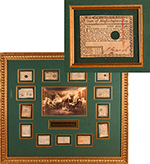 |
[Colonial America] Complete Set of Colonial Currency: One Note From Each of the 13 Colonies, This is a complete set of original, genuine paper money from all 13 colonies from the days of the signing of the Declaration of Independence. The set is 100% museum framed with all notes encapsulated in mylar. The framing is done with handwrapped 100% Hunter green linen with a Federal style frame. Gold wood fillets surround each item. Each note varies in condition, ranging from fine to very fine. Framed under UF3 AR museum-grade plexiglass to an overall size of 39 x 34 inches. A beautiful display item. Inquire for a list of the notes.
Estimated Value $3,500 - 5,500
View details and enlarged photo
| Unsold |
Lot 88 |
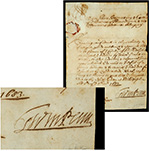 |
[Colonial America] Penn, William (1644-1718) English Quaker, Proprietor and Colonial Governor of Pennsylvania. Document signed ("Wm Penn"), 1p, 9¾" x 7¼", Philadelphia, 3 July (3d of ye 5th month) 1683. During his first visit to Pennsylvania, William Penn appoints John Goodson as coroner of Philadelphia.
Addressed "To John Goodson Chirur[ge]on in Philadelphia, the documents reads: "William Penn Proprietary & Governr of ye Province of Pennsilvania & the Territories thereunto B[e]longing. Reposing confidence in thy sobriety & Integrity, I do authorise & appoint Thee to be Coroner of ye county of Philadelphia to inspect ye Bodies of those yt come untimely to their Deaths, & impannel Juries upon the same, & do what to ye Office of a Coroner belonges, & to receive ye Fees due for ye same, as by Law directed: Hereby requiring all Persons to give thee ye Respect due to thy Office…."
John Goodson (?-1727) was the first English physician to arrive in Pennsylvania under Penn's charter. Goodson was appointed "chirurgeon" to the Free Society of Traders and resided in Pennsylvania prior to Penn's first visit. Goodson was made a judge in 1685, and in November of 1694, Penn appointed him Deputy-Governor to Governor Markham; he was also an Elder of the Quakers.
The document is age-toned, with one stain in the upper portion of the first letter, a couple of small archival tape repairs on verso, and a few small edge chips, slightly affecting one letter of the text. Goodson's docket ("My Commission from Governor Penn To be Coroner") has been affixed to the verso (integral leaf not present); verso also has a penciled notation, "B.T. Mendenhall to J.T. Watson Oct. 1855." The document is boldly penned with a large, bold signature by Penn. Early land grants from Philadelphia are not uncommon, but documents this unusual and early are very rare. This is one of the earliest, if not the earliest, surviving medical appointments in America and is the first appointment of a coroner in the colony of Pennsylvania.
Estimated Value $10,000 - 15,000
View details and enlarged photo
| Realized
$19,800 |
Lot 89 |
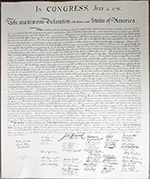 |
Declaration of Independence - Engraved by E.M. Weeks, 1939, Hand-engraved exact facsimile of the original Declaration, from a steel plate ordered by the Bureau of Engraving and Printing in 1936. Engraver Edward M. Weeks spent 1,318½ hours engraving the 26 x 31 in. steel plate that was finished in 1939. At lower left of the document is printed: "Facsimile of the Original / Engraved on Steel at the Bureau of Engraving and Printing by E.M. Weeks, Sc / 1939." Laid to board. The model for this intaglio print was from a photograph of the original Declaration of Independence taken by Levin C. Handy in 1903.
Estimated Value $1,000 - 1,250
View details and enlarged photo
| Unsold |
Lot 90 |
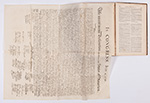 |
DECLARATION OF INDEPENDENCE In Peter Force's American Archives, Beautiful copy of the Declaration of Independence on thin, translucent paper (sometimes called rice paper) 25½ x 29 in., still as originally folded into Volume I of American Archives: Fifth Series. Containing A Documentary History of The United States of America…. Washington, April, 1848. Fine; three vertical and three horizontal folds, a couple of tiny toned spots; a tear at top edge and a couple of fold splits can be easily repaired. Easily removed from volume and framed for display. The front cover and first two end pages of the volume are separated, not affecting the Declaration of Independence.
In 1823, William J. Stone was commissioned by Congress to create a copperplate from which facsimile copies of the Declaration could be made. He did this by wetting the original document and transferring some of the original ink to the copperplate. From this plate, Stone printed 201 copies on parchment, which were given to President James Monroe, original Signers, members of Congress, colleges and institutions, etc. Stone's personal copy is in the Smithsonian. Only 31 of Stone's original 201 copies are known to exist; nineteen of these reside in museums and examples are rarely offered for sale.
In 1833, Congress authorized Peter Force to make up to 1500 copies of the Declaration from the original Stone copperplate. Force burnished out Stone's imprint and added a new one, "W.J. STONE SC. WASHN." at lower left. Force intended the copies for a projected 20-volume series, called American Archives, of primary sources of American history from the 17th century to 1789. The series was sold by subscription and work commenced under contract with the Department of State and by Act of Congress. Nine volumes were published from 1837 to 1853, covering the years 1774-76. Subscriptions were fewer than expected, and Force stopped work on the project when further funding was not forthcoming. The actual number of copies of the Declaration of Independence printed is unknown, ranging from 500 to around 1,000. It is not known how many of these copies have survived. Most copies of the Declaration have been cut from American Archives and sold individually.
Estimated Value $12,000 - 15,000
View details and enlarged photo
| Realized
$18,000 |
Lot 91 |
 |
Franklin, Benjamin (1706-1790) American statesman, philosopher, author, inventor, printer, and scientist; signer of the Declaration of Independence. Document signed ("B Franklin") as Commissioner to France, 2 pages, 8 x 12½ in., Passy, France, 7 August 1872. Franklin vouches for the fact that a naval commission as Captain in the U.S. Navy was issued to Gustavus Conyngham (c. 1744-1819), the famous "Dunkirk Pirate." The commission had been seized by the French in 1777 when his ship, the Surprise, his crew, and his prizes were seized while in the French port of Dunkirk. Franklin boldly signs his name to the document, which reads:
"I do hereby certify whom it may concern, that the Commissioners of the United States of America at the Court of France, did issue on the first Day of March One Thousand Seven hundred & Seventy Seven, to Captain Gustavus Conyngham a Commission of Congress appointing him a Captain in the Navy of the said States and to command a Vessel then fitting out at Dunkerque on their Account to cruise against their Enemies, in which Vessel he took the English Packet Boat going from Harwich to Holland. But their [sic] being no War at that Time between France & England, and the Clandestine Equipment of an armed Vessel in a French Port to cruise against the English being therefore an unjustifiable Proceeding, he was apprehended by Order of the French Government and his Papers seized, among which was the said Commission, which was never restored, and cannot now be found. It is therefore at the Request of the said Capt. Conyngham, and to ascertain the Fact that such a Commission was issued to him, I give this Certificate at Passy, this 7th Day of August, 1782. B. Franklin Minister Plenipotentiary from the United States of America at the Court of France."
Irish-born American naval officer Gustavus Conyngham was in command of a small ship called the Charming Peggy from September 1775, when he sailed for Ireland with a cargo of flax seed, intending to return to the U.S. with military supplies. He purchased the supplies in Holland, as planned, but the British consul in Ostend was informed of the military cargo, and prevailed upon the Dutch government to prevent the sailing of Conyngham's ship. The stranded Conyngham escaped to Dunkirk.
The American commissioners at the Court of France appointed Conyngham Captain in the U.S. Navy, filling out one of the blank "commissions for fitting out privateers in France" signed by the President of Congress and dated March 1, 1777, and gave him command of the lugger Surprise, partly owned by Congress and partly by William Hodge, a Philadephia merchant in France. The ship was fitted out with ten guns and went to sea about May 1, returning almost immediately to Dunkirk with two prizes, one of them an English mail packet from Harwich. The British expressed their outrage to the French (the Treaty of Utrecht, concluded between France and England in 1713, expressly closed the ports of either power to the enemies of the other), and the French had no choice but to order the arrest of Conyngham and his crew, taking his papers from him and seizing the ship.
The American commissioners obtained Conyngham's release and he was appointed Captain in the Continental Navy under a new commission (dated 2 May 1777) and given command of the 14-gun cutter Revenge. Conyngham wreaked havoc with the Revenge, taking 60 prizes in just 18 months and creating panic in Engand. Insurance rates went up--boats running between Dover and Calais had to pay ten per cent--and travelers were afraid to go to sea. Prints were issued in London and Paris, referring to him as the "Dunkirk Pirate" and caricaturing him as a ferocious pirate with a belt full of pistols and a sword in his right hand.
Within 18 months, he had taken 60 prizes, his cruises (often from Spanish ports) taking him as far away as the Azores and the Canary Islands. On February 21, 1779, he returned to Philadelphia and his ship was fitted out as a privateer. Setting sail again, he was captured by the British naval vessel Galatea on April 27, 1779, off New York. He was sent to Mill Prison, Plymouth, England in irons, from which he escaped on his third try (November 3, 1779), and he embarked from Holland on John Paul Jones' flagship, the Experiment. The vessel was taken by the British on March 17, 1780 and Conyngham found himself in Mill Prison for another year; he was exchanged shortly before news of peace arrived.
After the war, Conyngham returned to the merchant service. He tried to re-enter the Navy but failed. He also failed to get compensation for his services during the war; however, Benjamin Franklin, who, when Conyngham was captured, had said, "He has done so much harm to the enemy that he can expect no mercy at their hands," intervened on his behalf and Conyngham's March 1, 1777 naval commission as Captain in the Navy was restored on August 7, 1782 by means of the letter offered here.
The letter is written on laid, watermarked paper. Ironically, the watermark on one page shows a robed Britannia seated beside a rampant lion within the enclosure of a picket fence; Britannia supports a spear holding a hat; to the left of the spear is "Pro Patria"; on the other page is "GR" below a crown. Fine, with a magnificent, large and bold signature of Franklin and the red wax seal intact at the left. There are a few small edge splits at folds and mounting remnants down one edge of the verso of the integral blank leaf. The letter is housed in a handsome blue slipcase with red leather labels printed in gold. A significant and utterly fantastic document showing the American government helping a privateer who was of immense aid to the American cause during the Revolutionary War.
Estimated Value $25,000-UP
View details and enlarged photo
| Realized
$46,800 |
Lot 92 |
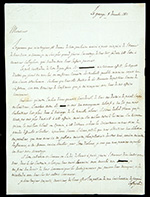 |
Lafayette, Marquis de, Autograph letter signed ("Lafayette") 1 page, 9¼ x 6¾ in., in French, La Grange (France), 8 Dec. 1817. To Vice-Admiral Sir Josiah Coghill, regarding the death of his brother (Sir John Coghill) and his claims to land in Louisiana. All references to Coghill were struck with ink at an early date. Fine; one short fold separation and one small prior mounting remnant on verso. Boldly penned and signed. Accompanied by a transcription and translation.
An important letter regarding land claims of over 11,000 acres in Louisiana which Congress awarded Lafayette in 1803 for his service in the American Revolution. At the time of this letter, Lafayette was in financial straits, having lost his personal fortune during the French Revolution. To pay off a debt he sold roughly half of that land, part of the Point Coupee tract, to Sir John Coghill. Upon Coghill's death (21 May 1817), title passed to his brother Josiah, the recipient of this letter. In addition to the land at Pointe Coupée, Coghill purchased a small tract in New Orleans from Lafayette. Subsequent to the sale, however, Lafayette's title to the valuable tract was called into question, explaining the reason for this letter.
In part: "…The unexpected loss of your worthy brother…deeply affected me….Knowing that you are heir to his happy disposition, as well as his fortune, it is with a great deal of confidence that I deal with you concerning our mutual business. You know that in addition to the purchase of a considerable quantity of land in the Pointe Coupée district in Louisiana, there existed between Sir [John] and me an arrangement regarding a plot of land…in the neighborhood of New Orleans. He was astonished at first that I hadn't put more effort into this affair, but after involving himself in the matter he recognized that with the best of intentions one experiences great difficulties at this distance and in the circumstances in which we were; however, it might be possible to obtain a solution in the spring, since we have here Mr. [Albert] Gallatin, minister plenipotentiary of the United States, former minister of finance, and Mr. [James] Brown, former senator for the state of Orleans [sic]. I believe that we will be able to discuss it to good effect this winter. If your intention is, as is said, to come to Paris, I will have the honor of talking about it with you; should it be otherwise, when you have examined my progress with **** I will make it a duty to communicate to you the information that you might be missing and to come to a mutual understanding with you on our common interests. I will always be prompt, sir, to offer you the expression of my utmost esteem. Lafayette."
Even with the assistance of Gallatin and Brown, Lafayette's claims to the land were not resolved until the 1830s.
Estimated Value $3,000 - 4,000
View details and enlarged photo
| Unsold |
Lot 93 |
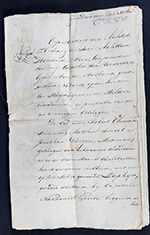 |
[Quasi War With France] 1804 Dutch Document Relating to French Spoliation Claims, Twenty-page manuscript document in Dutch, dated 8 Feb. 1804, regarding the ship Zephyr, captained by Nathaniel Peirce. The Enlish docket says, "Protest, Exhibited to the President and Directors of the Newberry Port Marine Insurance Company, June 30 1804." Red wax seal on the 13th page. Untranslated; overall toning and light soiling.
Spoliation claims are claims presented by United States citizens against France, Spain, and Holland for vessels and cargo taken by privateers prior to September 30, 1800, and condemned at ports controlled by those countries. Most of the vessels were captured during the Quasi-War between the United States and France (1797-1801).
Estimated Value $300 - 400
View details and enlarged photo
| Unsold |
|
|